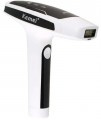—
Floating head. Epilators equipped with this feature possess a head attached to a nozzle that can flex in multiple directions from its initial position. This design enables the device to precisely track the body's contours during movement, thereby enhancing processing efficiency and diminishing discomfort.
—
Wet epilation. Capability to perform epilation on damp skin is a feature found in certain devices. These models are often designed to be waterproof, allowing them to be used during baths or showers, and they can also be
rinsed under water. This practice is grounded in the idea that moistened skin is less sensitive and hairs are more pliable. Consequently, wet hair removal tends to be more comfortable and gentle compared to dry hair removal—even without specialized tools. The inclusion of foams, gels, and other specialized cosmetics can further alleviate discomfort during the procedure. However, it's important to note that incorporating support for wet hair removal significantly impacts the device's price.
—
Massage system. Device for skin massage. In some epilators, the massager is built-in and works right during epilation. In other models, it looks like a nozzle worn on the epilator. Anyway, massage is not just pleasant — it improves blood circulation and the general condition of the skin, promotes relaxation and so
...othing, and during epilation it also reduces discomfort, while simultaneously contributing to high-quality hair removal.
— Possibility of washing with water. Capability for water-based cleaning of the shaving head. This approach is frequently more practical and efficient compared to dry cleaning methods like using a brush. It's important to distinguish that being washable with water doesn't necessarily imply suitability for wet epilation (as mentioned earlier).
— Backlight. Incorporated illumination directed towards the skin beneath the head cover. It's worth noting that this feature remains beneficial even in decent external lighting conditions. The overhead lighting might not suffice for clear visibility of hairs, particularly those that are light and fine. Illumination proves advantageous during the entire procedure, but it becomes exceptionally convenient when verifying results and addressing any shortcomings.
— Synchronization with a smartphone.The capability to synchronize the epilator with a smartphone or similar device, which hosts a dedicated application, constitutes a primary convenience of such models. The application offers various supplementary functions. Among the most popular features is an epilation calendar that allows users to track performed procedures and plan for the future. This calendar can consider factors like hair growth rate, skin recovery time, and more. Other possibilities encompass selecting the optimal mode based on skin type and epilation area, calculating procedure duration, displaying battery status, and more. Specific details for each scenario should be addressed individually. Typically, communication with a smartphone occurs through Bluetooth.
– Display. The display in the design of epilators is used to display the settings and selected operating modes (power level, nozzle destination area, remaining battery charge, etc.). In photoepilators, it also shows the number of flashes in stock, which allows you to keep the lamp life under control.The time between two separate lamp flashes. The shorter the interval between pulses, the faster you can move the device and the less time the procedure will take.
The photoepilator lamp has a guaranteed lifespan in terms of the number of flashes it can emit before it becomes depleted and ceases to function. Ideally, this number should be a minimum of 750 flashes (0.75K). In certain models, the lamp's longevity can extend to tens of thousands of flashes.

